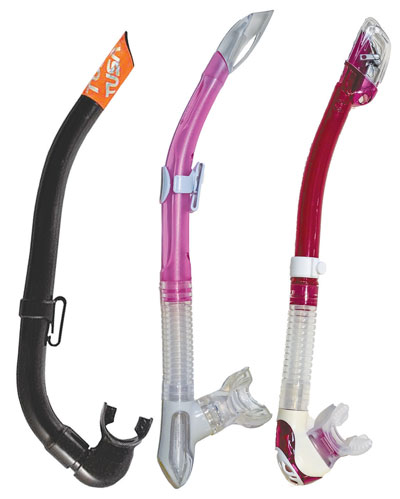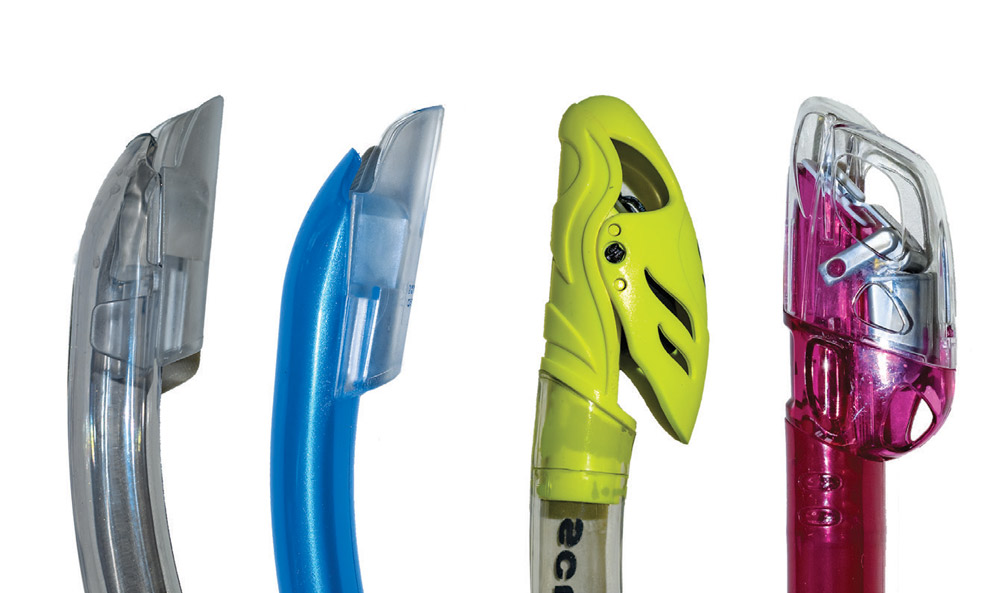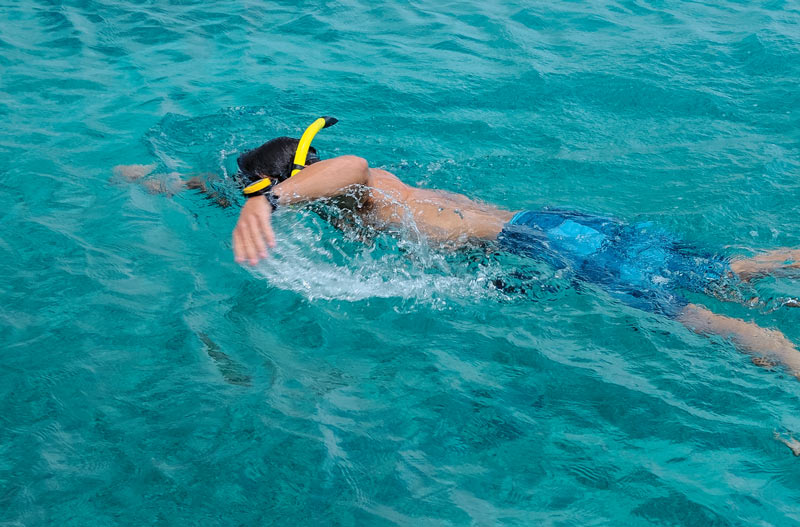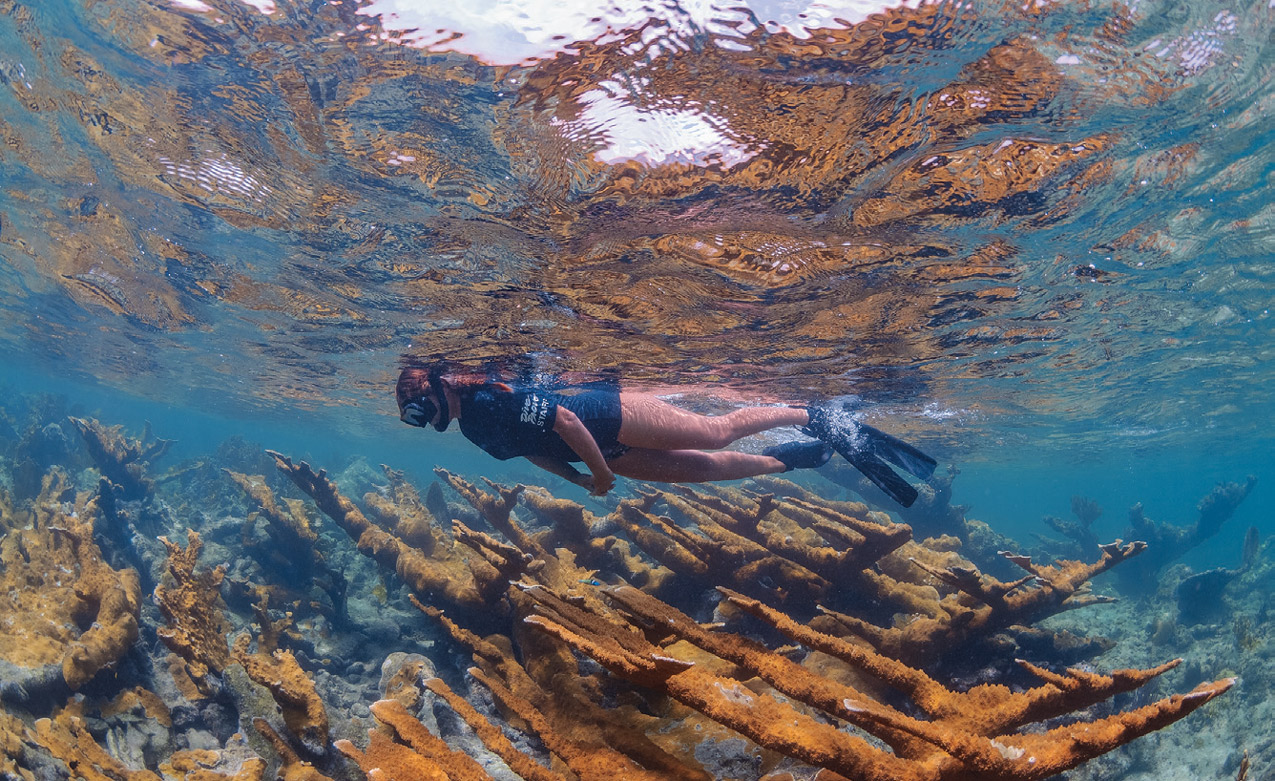SNORKELING opens up a new dimension to those who enjoy the beauty of our underwater world. It’s a great first step leading to scuba diving. And for those who are already certified scuba divers, there are times when scuba gear is either not necessary for exploring shallow areas — or is prohibited. Examples of “snorkeling only” adventures where scuba is not allowed include manatee encounters in Florida’s Crystal River region, swimming with whale sharks off Isla Mujeres and Holbox, Mexico and the Philippines’ Oslob marine park while marveling at humpback whales off the Dominican Republic.
To become a skilled snorkeler you’ll need the proper equipment and a few lessons. The staff at your local dive center can assist you with selecting a suitable snorkel, as well as a properly fitting mask, a pair of fins and the right exposure protection for your environment. They can also teach you a few techniques to make snorkeling easier and more enjoyable.
Selecting a Snorkel

There are essentially three types of snorkels — basic, semi-dry and dry. Photo by Barry and Ruth Guimbellot.
The snorkel attaches to your mask and allows you to keep your face in the water, enjoying the underwater sights while breathing surface air — you don’t have to raise your mouth out of the water in order to take a breath. There are essentially three types of snorkels — the basic, the semi-dry and the dry snorkel. No matter which style you select, all snorkels are equipped with a breathing tube and a mouthpiece designed to fit comfortably in your mouth.
The basic “no bells and whistles” snorkel consists of a breathing tube that forms a “J” at the mouthpiece end.
The semi-dry snorkel adds a splashguard positioned on the top of the snorkel, which is intended to deflect splashing water from the opening. Any residual water that enters the tube is easily expelled from a purge mechanism located at the bottom of the tube.
The dry snorkel differs from the basic and semi-dry snorkel in that it is designed with a “dry top” feature intended to prevent water from entering the snorkel when diving underwater or when in choppy surface conditions.
A comfortable mouthpiece made of silicone is also important when selecting your snorkel. It should stay put when the jaw is relaxed — having a flexible corrugated bend adjacent to the mouthpiece will help keep it from popping out of your mouth unintentionally.

The left two snorkel tops are semi-dry styles and the two on the right are dry styles. The basic snorkel barrel doesn’t have any special feature on the top. Photo by Barry and Ruth Guimbellot.
The Mask
Fit is the primary consideration when selecting a mask. The mask should seal to your face without leaking; it should be low-volume with a nose pocket accessible for easy equalization and you should be able to see through the lens or lenses clearly from it. (Prescription lenses are available, so if you normally wear eyeglasses or contacts, ask your dive center professional about this option.) Ideally, select a mask suitable for both scuba diving and snorkeling. If you intend to pursue freediving for game hunting or competition, ask about masks designed especially for these purposes.
Prepare your new mask for its first use according to the manufacturers’ instructions. Mask defog is an essential accessory.
RELATED READ: HOW TO SELECT A MASK AND PREVENT FOGGING
Attaching the Snorkel
Once you’ve selected the right mask and snorkel for your use, you’ll want to attach the snorkel to the mask. This is done using a snorkel clip or keeper that typically comes with your snorkel. Extra clips or snorkel keepers are sold as an accessory. The staff at your dive center can help you attach the snorkel to your mask strap so that the mouthpiece fits comfortably when in the mouth. With the mouthpiece in place, the tip of the snorkel should be over the crown of your head when facing down in the water. This position places the tip of the snorkel at its highest point, making it more difficult for any water to get into the tube. When in an upright position, the top will be slightly behind your head.
Fins
Fins will help you move about while snorkeling. The type and style of fins you select will be based upon the environment and your individual preferences. Discuss the various options with dive center staff, but generally, it’s best to select fins that fit comfortably and will help provide good propulsion while snorkeling.

It isn’t necessary to use your arms for swimming when snorkeling. Instead, keep your arms relaxed by your side and propel yourself using your fins. Photo by Barry and Ruth Guimbellot.
Exposure Protection and Snorkeling Accessories
To protect against sun exposure, scrapes and stings, we suggest you cover your skin by wearing a long-sleeved rash guard or even a full skin suit. Even in the tropics a lightweight wet suit will provide sun protection, insulation and a bit of buoyancy for floating comfortably on the surface as a snorkeler. To prevent painful sunburn, 30 minutes or more before snorkeling, apply a water-resistant “reef safe” sunscreen. Remember to apply sunscreen to the back of your neck, ears and legs, too.
Store and carry all your snorkeling gear in a zippered or drawstring mesh bag and you’ll get to and from the dive site with ease.

Be careful to avoid accidentally coming into contact with the reef. Photo by Barry and Ruth Guimbellot.
Snorkeling Safety
Snorkeling is relatively simple, but a few special techniques and suggestions will make it easier and safer. For example, when you are on the surface, stay alert to boat traffic and other potential hazards. Whenever possible, snorkel in designated areas or carry a dive float and flag that makes you more visible. Never snorkel in an active boating lane.
It is best to keep your arms relaxed by your side and let the fins do all the work. It is not necessary to use your arms for swimming. Small, steady strokes with the fins will allow you to smoothly glide through the water.
If you intend to dive below the surface, do so with a buddy using a one up/one down technique, that is, your buddy remains on the surface monitoring your dive while you go below, and you do the same for them you take turns diving/supervising. When making repeated dives, remember to breathe normally before you descend and rest and “catch your breath” for several minutes between dives. Hyperventilation and performing multiple surface dives in short succession can contribute to a potentially dangerous situation called shallow water blackout. Your snorkeling instructor or guide will provide you with detailed information on this topic, including proper breathing and buddy procedures to stay safe as a snorkeler.
If you find you are too buoyant, wearing a weight belt with a small amount of weight will make it easier to dive below the surface. On the flip side, if you wish to remain on the surface or are having trouble floating or feel unsure and a little nervous, use a snorkeling jacket to provide extra buoyancy and comfort.
Pay attention to your surroundings while snorkeling to avoid coming too close to delicate corals that you might damage or could injure you. Hard corals are sharp and can leave a bad scratch if accidentally scraped. Other corals, such as fire coral, can produce painful, stinging welts.
While divers and snorkelers often share the same dive site, as a snorkeler you should never share air with a scuba diver. Breathing compressed air when not on scuba can result in a serious injury to you, the snorkeler.

Before entering the water, get with your buddy to double-check your equipment for proper fit. Photo by Barry and Ruth Guimbellot.
Before entering the water, you and your buddy need to determine some helpful hand signals in the event you need to communicate with each other. Discuss a basic plan such that includes which direction you will go, how far you will go and how long you will snorkel. Next, double-check the equipment to be sure it is in good shape and is fitting properly.
It is easy to become immersed in the beauty and excitement of all you see below the surface, however, it is important to keep track of your location. For example, mild currents can push you off track without you realizing it. To avoid such surprises, frequently perform a visual check to see your position in relation to your entry/exit point.
Resort areas often have boats that offer snorkeling excursions. If you snorkel from a boat, listen carefully to your guide’s briefing and follow the rules.
When the snorkeling’s done, thoroughly rinse your gear in fresh water and place it out of direct sunlight to dry, then store away from heat.
Snorkeling is a fun, easy way to enjoy the marine world. It often opens the door to another exciting sport scuba diving. Who knows, maybe earning your certification in scuba diving will be your next big step to amazing adventures.




